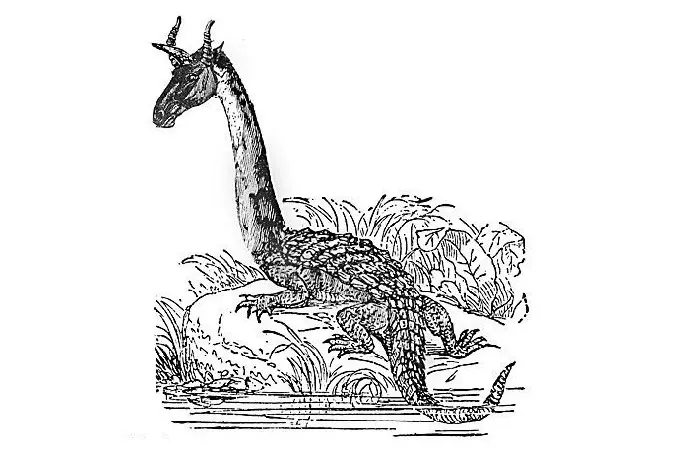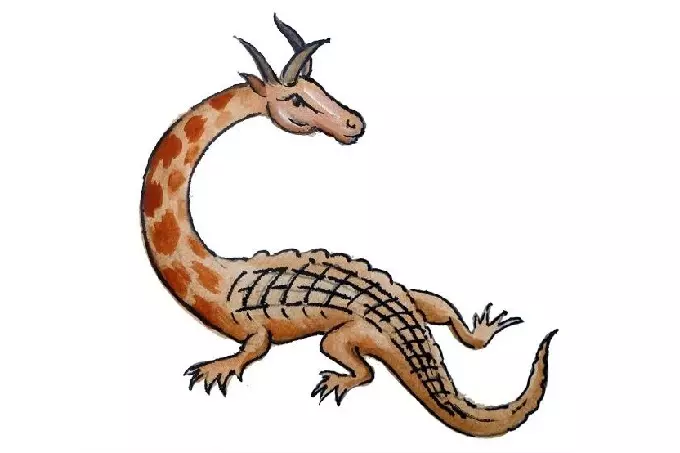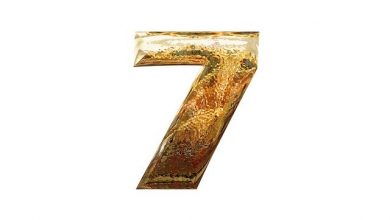Mysterious Gambian dragon Ninki-Nanka

The Gambia, stretched out in a narrow strip off the coast of the Atlantic Ocean, is the smallest independent African state. In recent years, this country has attracted the attention of cryptozoologists thanks to a mysterious creature called “Nninki-Nanka”.
This is the name of a nine-meter reptile in the local dialect, allegedly living in mangroves in the remote inner areas of The Gambia. It has the body of a crocodile, the neck of a giraffe, and a head with three horns. The third horn is located in the middle of the head, closer to the forehead. The reptile spends most of its time immersed with its head in swamp mud, so it is extremely difficult to see it.
White people first heard about Ninki-Nanka in 1935, when the French doctor Andre Salier visited the Gambia during the malaria epidemic. Aborigines believe that the Ninki-Nanka lives in the evergreen rainforests in the Abuco Reserve. According to the beliefs of the Fulbe people, a person who manages to kill Ninki-Nanku will become incredibly strong and will live two hundred years.
On the other hand, the monster can kill a daredevil by piercing him with horns or tearing him with teeth sharp as a crocodile’s. If this happens, the warrior’s family will also suffer — they are all waiting for illness and painful death.
It should be noted that Andre Salier did not see the Ninki-Nanku, but according to the Africans, he drew this animal. One of the famous English cryptozoologists, Chris Moiser, suggested that the Ninki-Nanka is perhaps a miraculously surviving marine reptile of the Mesozoic era, most likely a plesiosaur. Moiser often publishes articles in various magazines devoted to bigfoot, English giant cats, Australian Yovi, the moth man from Point Pleasant. He is considered a recognized authority in cryptozoology.
The Fulbe people believe that the monster has mystical powers, and pray to him when floods occur during the rainy season. According to their beliefs, Ninki-Nanku can be appeased, and then the prolonged rains, more like a solid wall of water, will stop. Fulbe people, who live by cattle breeding, sacrifice suckling pigs to the monster.
In May 2004, Chris Moiser organized an expedition to the Gambia with his own money, hoping to learn more about the monster, and, if possible, to see it. From the Gambian capital of Banjul, Chris and two hired porters drove a jeep on a bad road, and then walked 40 kilometers.

The purpose of the trip was the remote village of Salo, located on the outskirts of a vast mangrove swamp. It was in these places that a French doctor visited in 1935. It turned out that talented craftsmen-minters live in the village. They make beautiful silver jewelry, mainly hryvnia. The leitmotif of the engraved images is Ninki-Nanka, a horned crocodile.
The villagers were happy to tell the guest about Ninki-Nanka. They are all sure of its existence: mothers and fathers, grandfathers and grandmothers of the current inhabitants of Salo met with the monster.
A guy named Dulik told a tragic story about the death of his fa ther. He wanted to gain unprecedented strength and went hunting for Ninki-Nanka. By tradition, the warrior must be alone, collective hunting is not allowed. The daredevil left and did not return. A week later, his gnawed bones were found on the outskirts of the swamp. The tribesmen decided that Ninki-Nanka had killed Dulik’s father, and hyenas had gnawed his body.
Moiser wanted to talk to a man who had personally seen the owner of the mangrove swamps. And there was one. He was an ancient old man who rarely got up from the mat laid in the hut. The Englishman was escorted to an old man in a straw hut.
The old man mumbled for a long time with a toothless mouth, but then he told me that once, about twenty years ago, he saw a Ninki-Nanku in the swamp. — He’s huge, bigger than an elephant, and scary! The crocodile’s muzzle is the size of a hut, and the teeth are white, sharp, in several rows. Every tooth is the size of my finger. The old man stretched up a skinny hand, showing withered fingers. — Yes, yes! He would have bitten me in half, but he couldn’t get out of the mud quickly, the swamp sucked him in.
Ninki-Nanka never comes out of the swamp. I heard him making noise and snorting: “Fff-fff!” — the old man tried to convey the sounds made by the monster.
Chris was surprised by this story, and he was no less surprised to learn that his interlocutor was not even forty years old. The villagers had no doubt that the evil Ninki-Nanka had sent the disease to the unfortunate.
None of the Fulbe agreed to accompany Moiser to the swamp, and he had to go alone. It ended badly. The swamp turned out to be almost impassable, despite the special devices that the researcher brought with him.
In addition, Chris was bitten by a malarial mosquito. Two weeks later, Moiser had a fever and went down. He didn’t have the strength to continue searching for Ninka-Nanki.
Chris returned home with nothing, although he believed even more in the existence of a monster. He hoped to return to The Gambia and find the mysterious horned crocodile.
In 2006, a group of “dragon hunters” from the Center for Anomalous Zoology (CFZ) traveled to The Gambia in the summer to investigate reports of the Ninki-Nanka and obtain testimony from those who claimed to have seen this mythical creature. The head of the group was cryptozoologist Richard Freeman.
The team interviewed the caretaker of Kiang West National Park, who told about his meeting with Ninki-Nanka three years ago. According to him, it was a huge green animal, reaching 50 meters in length.
The hunters showed the caretaker several pictures with reptiles and mythical creatures depicted on them. From the proposed illustrations, he chose a drawing of a Chinese dragon.
The expedition, known as the 2006 Downes Memorial Gambia Expedition, received relative media attention, including coverage in a separate article on BBC Online. But no convincing evidence of the existence of this animal was found.
It should be added that not all scientists share the enthusiasm of Moiser and Freeman. An authoritative historian, an expert on African cultures, Dr. Kevin Johnson from the University of Cambridge believes that no reptile has ever existed in the mangrove swamps of the Gambia. This is supposedly just an image that makes up the content of the collective unconscious of the Fulbe people, which has been developed for thousands of years.




